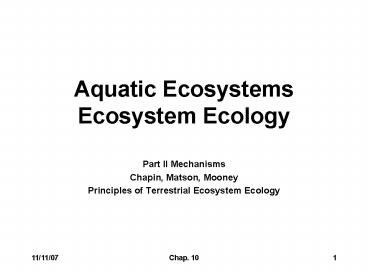Aquatic Ecosystems Ecosystem Ecology - PowerPoint PPT Presentation
1 / 55
Title: Aquatic Ecosystems Ecosystem Ecology
1
Aquatic EcosystemsEcosystem Ecology
- Part II Mechanisms
- Chapin, Matson, Mooney
- Principles of Terrestrial Ecosystem Ecology
2
Aquatic Ecosystems
- Governed by same principles as terrestrial
ecosystems - Radically different environmental controls
3
Terrestrial and aquatic ecosystems have
fundamentally different physical environment
4
Aquatic plants have No physical support
structures Small size to maximize diffusion
rates Rapid reproduction to cope with water
mixing and grazing
5
lv K
Reynolds number
Where l length v velocity K viscosity
constant
6
Size determines feeding strategy Small organisms
cant swim Depend on diffusion Large cells can
sink or float Move vertically Medium-sized
organisms can filter-feed Large organisms can
swim Can chase prey
7
(No Transcript)
8
(No Transcript)
9
Some marine ecosystems are just as productive as
the most productive terrestrial ecosystems The
most widespread marine ecosystems are
unproductive
10
What limits marine production?
- Water? (no, except intertidal)
- Strong contrast with terrestrial systems, where
water is the dominant limiting factor - CO2? (no, except sometimes intertidal)
- CO2-bicarbonate-carbonate equilibrium supplies
CO2 - Light? (always at depth)
- Nutrients? (usually)
11
More light penetrates to depth in oceans than on
land Marine production is restricted to top 200m
(Euphotic zone) Light limits production within
and below this zone
12
Light quality differs between marine and
terrestrial Ecosystems 1. Ocean water enriched
in blue (high-energy wavelengths penetrate
deeper) 2. Forests enriched in red (plants
remove high-energy wavelengths for Ps
13
Marine phytoplankton are like terrestrial shade
plants
- Low photosynthetic capacity
- Spend most time in light-limiting environ
- (due to frequent mixing)
- Sensitive to UV radiation
- Some specialized to use blue light
- e.g., kelps
14
Ocean currents create radically different
environments Centers of gyres have little
mixing Off-shore currents cause upwelling Warm
oceans have high vertical stability (not much
vertical mixing)
15
Nutrient concentrations of euphotic zone are
highest in upwelling currents Always depleted
at surface by algal uptake
16
North Pacific is relatively nutrient-rich zone
of thermohaline-driven upwelling westerly storms
mix surface waters cold surface waters are
weakly stratified (especially in winter)
17
Latitudinal gradients in productivity
- Polar oceans are most productive
- More effective mixing of nutrients from depth
- Polar lands are least productive
- Less rapid nutrient release from SOM
- Consequences
- Bipolar fish and mammal migrations
- Polar distribution of anadromous fish
18
Major upwelling zones off Peru, Africa Outer
Banks, North Pacific California, North
Africa Wind-mixing off Antarctica
19
Strength of tropical upwelling off Peru depends
on ENSO
20
(No Transcript)
21
Strong recycling component to marine nutrient
cycling
- Most nutrients recycle within the euphotic zone
- Microbial loop
- Bacteria production contributes to food chains
that feed fish
22
What are the limiting nutrients in the ocean?
- NP ratio of ocean waters centers on 141 (ratio
found in algae) - Phosphorus is the master element
- N fixation adds N, whenever P is available
23
NP ratio in oceans centers around 141 Redfield
ratio
24
Water chemistry conforms to same element ratio
as in algae--141 N fixers always add N,
whenever this ratio drops
25
Some regions of oceans have high N and P conc.
- Common in subtropical gyres and southern ocean
- Two processes contribute to this
- 1. Micronutrient limitation
- Iron addition experiments
- 2. Grazing
26
(No Transcript)
27
Coastal oceans and estuaries
- More nutrient-rich
- Closer to terrestrial inputs
- Benthic decomposition more important
- Less time for decomposition to occur in water
- Often nitrogen-limited
- Perhaps due to denitrification in sediments
28
Lakes
- Intermediate between oceans and land
- Pelagic zone functions like ocean
- Littoral zone is like wetland
29
Latitudinal water balance
30
Global Distribution of Lakes
31
Global Distribution of Lakes
32
Origin of Lakes?
33
Origin of Lakes
34
Light
35
(No Transcript)
36
Light and Ice
37
Stratification
38
Stratification
39
Water movements
40
Lakes
- Production is seldom carbon-limited
- Groundwater is super-saturated with CO2
- Most lakes are net source of carbon to atmos
41
Lakes
- Vertical mixing is critical
- Occurs in spring and fall, when lake isothermal
- Wind and wave action drive the mixing
42
Lakes
- Nutrients are strongest limitation to NPP
- Lakes generally P-limited Why?
- Surrounding terrestrial matrix is N-limited
- Two basic explanations
- 1. P retained more effectively than N on land
- 2. Lakes add N through N fixation whenever P is
available
43
Lakes
- Lakes are vulnerable to eutrophication
44
Lake Nutrients
45
Lake Nutrient Limitation
46
Lakes
- Lakes are vulnerable to eutrophication
47
Lakes
- Lakes are vulnerable to eutrophication
48
Lakes
- Lakes are vulnerable to eutrophication
49
Lakes
- As in the oceans, N-fixation by cyanobacteria
important
50
Streams and rivers
- Directional movement of water in streams and
rivers greatly influences their functioning - Phytoplankton unimportant
- Would get swept away
- Periphyton are main producers
51
River continuum concept Transition in
structure/function along length of river
system inputs, organisms, energy flow
52
Nutrient spiraling
- Nu trients spiral horizontally
- Terrestrial systems vertical N cycling
- Nutrients held surprisingly tightly
- Flow downstream mainly in dissolved form
- Hyporrheic zone
- Flow also occurs within river bed
53
Nutrient spiraling
54
Nutrient spiraling
55
Hyporheic flow

